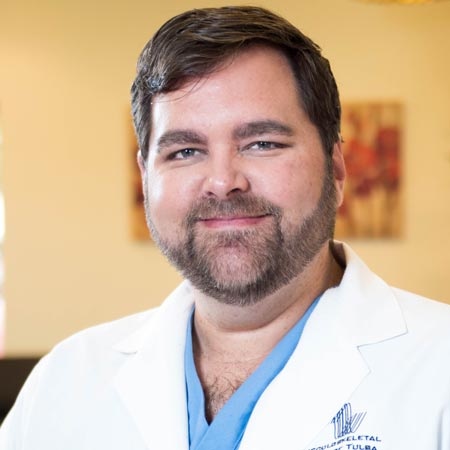This article was originally published in the May 2019 newsletter of the Tulsa County Medical Society.
Why this article? Yes, it’s Osteoporosis Month. I’ll assume most of my colleagues are familiar with basic Wikipedia level info, so this won’t be your typical regurgitation of factoids. No, my friends, this is about to get interesting.
As a musculoskeletal interventional radiologist, I’ve been lucky to have a niche practice that’s 95% clinical osteoporosis and interventional pain management. My practice has thrived because osteoporosis remains under-treated and missed.
Now, most of you who know me know I’m generally soft spoken. So sit back and allow me be a little “in your face” as I throw down the gauntlet. Some of your mothers never taught you to treat osteoporosis and it shows. It’s tax day, and I’ve had two new patients this month already who previously had a surgically treated HIP FRACTURE at local hospitals, but were NEVER medically treated for osteoporosis. I have the medical records. One of these patients was even told that she didn’t have osteoporosis, she had ‘osteopenia.’
This is 2019. We should be doing better.
Why is this still happening? If we can’t get docs to treat patients with prevalent fragility fractures, how will we ever come to terms with the impending tsunami of unrecognized secondary osteoporosis patients rolling our way? To optimally treat bone health, we need a little history to understand what attitudes (and barriers to treatment) are out there.
Osteoporosis Through The Ages
When I was a kid and people paid for music, osteoporosis was generally considered a normal part of aging. I still encounter doctors who say “old people just get hip fractures” Pardon me as I roll my eyes. Never mind the fact that some ‘old people’ do get fractures, while many don’t.
Then along came DXA and Fosamax reps with modestly priced in-office lunches ushering in what I call the “BMD paradigm” of osteoporosis. That is, low bone density causes osteoporosis/fractures. The BMD paradigm seems to be where many – if not most – Tulsa doctors remain today. Probably because it works for the masses of pre-fracture asymptomatic populations. That’s good, but the result is that many doctors never look beyond the T score or a FRAX. There are a million reasons that good doctors never go further, but you’re not one of them so…
So why is it not enough? Those of us that focus on osteoporosis see folks with fragility fractures but normal BMD. Often this is chalked up to the limited inherent accuracy of DXA (just like any test). Makes sense – maybe that patient just fell out of the arbitrary range limit WHO set on BMD. They had low BMD, but “the DXA is just missing them.” That’s still a very common thought process in Tulsa, but based on the now outdated “BMD paradigm.”
It’s 2019, and we (should) know that the problem isn’t just BMD. Osteoporosis in particular, and bone health in general, are a combination of both bone mineral density and bone quality. Put another way: BH = BMD + BQ. That paradigm has been around for at least a decade, so if you’re not on the bus, now is your chance. When I started my practice I was introduced to it by one of my mentors, the late David Brown. I have David to thank for stimulating my interest in osteoporosis treatment and looking for the underlying causes.
Secondary Osteoporosis
So what is secondary osteoporosis or low bone quality? The term arises from osteoporosis caused by something other than low density. Many patients have problems with both. The current ICD-10 terminology is entirely inadequate in my opinion, because I think we aren’t there yet in our understanding. But ask a spine or orthopedic surgeon who is less likely to heal after surgery, or have a nonunion – they’ll tell you smokers, diabetics, low thyroid, cardiovascular disease. The classic ‘metabolic trashcan’ patients.
Still reading and want to dive deeper? Here’s how I look at common causes of impaired bone quality:
Drugs: Steroids, PPIs, SSRIs (some risk with SNRIs, less established), anticoagulants, neuroleptics, chemotherapy, radiation, etc.
Hormonal derangement: thyroid, estrogen/testosterone deficiency, vitamin D deficiency (it’s a plant hormone), diabetes, etc.
‘Osteoporosis of Chronic Disease’: RA (independent of steroids), COPD, cardiovascular disease (vasculitis, lupus, smoking, diabetes again, maybe any heart disease), CKD, malnutrition (common in elderly, also post-GBP patients), idiopathic hypercalcuria, etc.
When we think secondary osteoporosis, we (should) typically think steroids as well as anticoagulants and anti-epileptic medications. However, there are now several significant longitudinal studies showing what I’ve seen over the last decade or so: SSRIs and PPIs increase fracture risk. Presumably this is by slowing bone turnover because they don’t generally decrease BMD. There’s still disagreement and denial in the GI literature. I think that’s partly reactive/defensive (not our fault) and partly because many are stuck in the “BMD paradigm.” I don’t have room to get into that other than to say the preponderance of evidence is that PPIs increase fracture risk without decreasing BMD. Definitely in vertebral fracture and probably in hip as well. I personally think this is worst in genetically susceptible individuals.
Future Osteoporosis Treatment
Does that mean we take people off of PPIs and SSRIs? Of course not – I’m not a madman. Even ignoring quality of life issues, an ulcer or suicide are more likely to kill people (morbidity and mortality) decades earlier than osteoporosis. And this brings be back to an underlying point – not everyone on a PPI will get osteoporosis. Until we have better ways to risk-stratify, we can’t justify it. Until that happens I just tell patients we consider them a ‘necessary evil’ and go back to working on “meaningful use”.
But it IS worth considering that the more bone health risk factors a patient has, the more likely they are to get osteoporosis early – and do poorly with surgeries involving metal and bone. And I don’t mean a low T score – I mean a fragility fracture, a periprosthetic fracture or – say – a pseudoarthrosis after cervical fusion. More importantly, it underscores the value of conservative therapy before we ‘go nuclear’ with meds that are now OTC. For example, if a friend mentions heartburn, are you more likely to recommend a PPI, or go into a Osler-like recitation of avoid mints, lose weight, don’t eat within 4 hours of bed, etc. There’s something to be said for the art of medicine and conservative therapy.
How do we treat osteoporosis with all of these complex causes and factors? I think the future is again in looking at the past. In my clinic and with most interventionalists leading the way, our approach to treating bone health is similar to what happened with cardiovascular disease in the 1980 and 1990s. Do the research, find causes and more effective and less invasive treatments. Identify risk factors and mitigate those. We preach smoking cessation. We correct vitamin D deficiency and try to work with the PCP to get diabetes and thyroid optimally managed.
Medical osteoporosis treatment is a calling and not for everyone. So, if you don’t do it, please find someone who does. If you want to do more I’m certainly happy to make recommendations and help you get there. I would be honored to be your David Brown.
I don’t expect everyone to pick up every osteoporosis patient. But can we at least agree on one thing? If a patient sustains a hip fracture from a standing height fall, for the love of Hippocrates, call it osteoporosis!
– James Webb, MD

